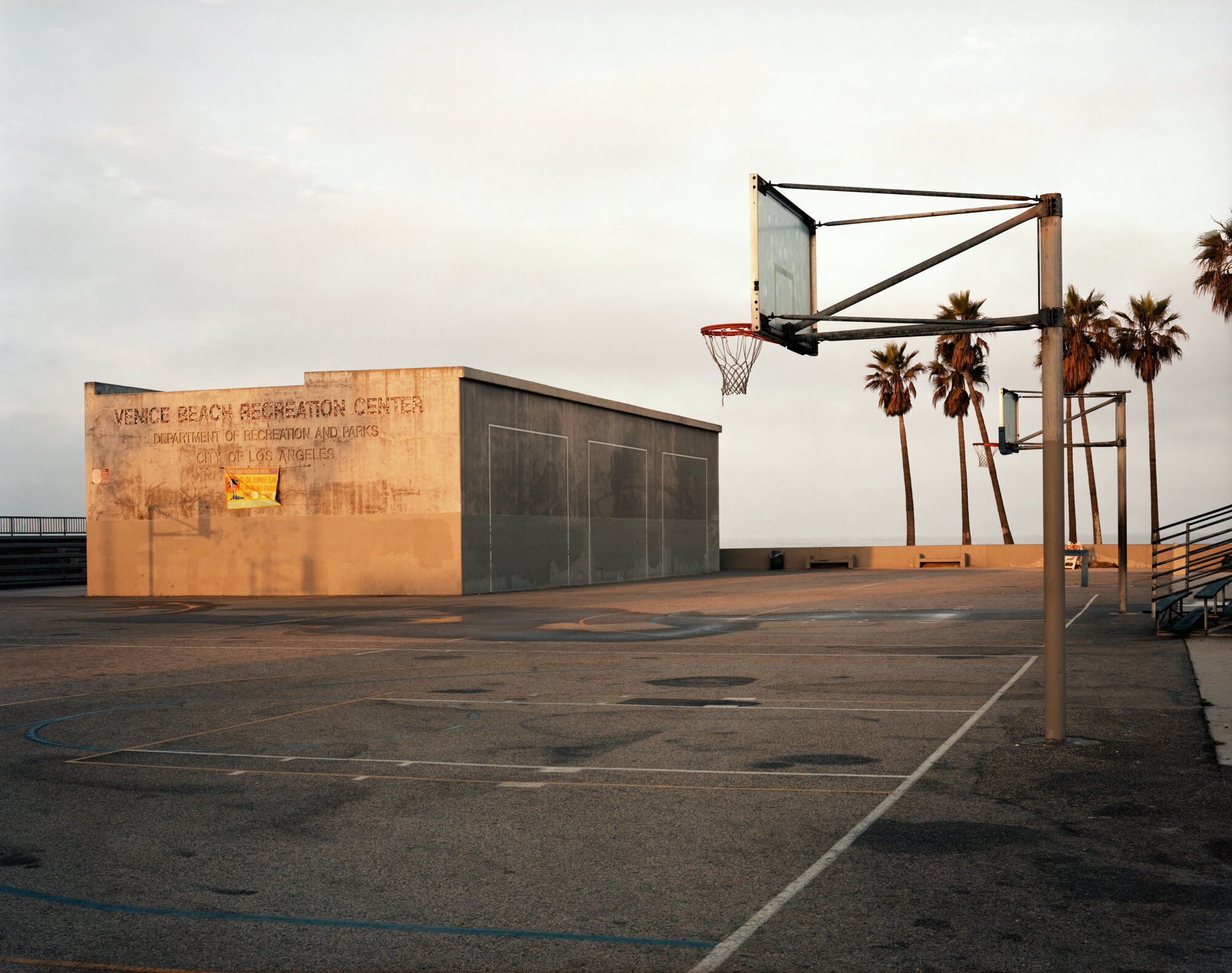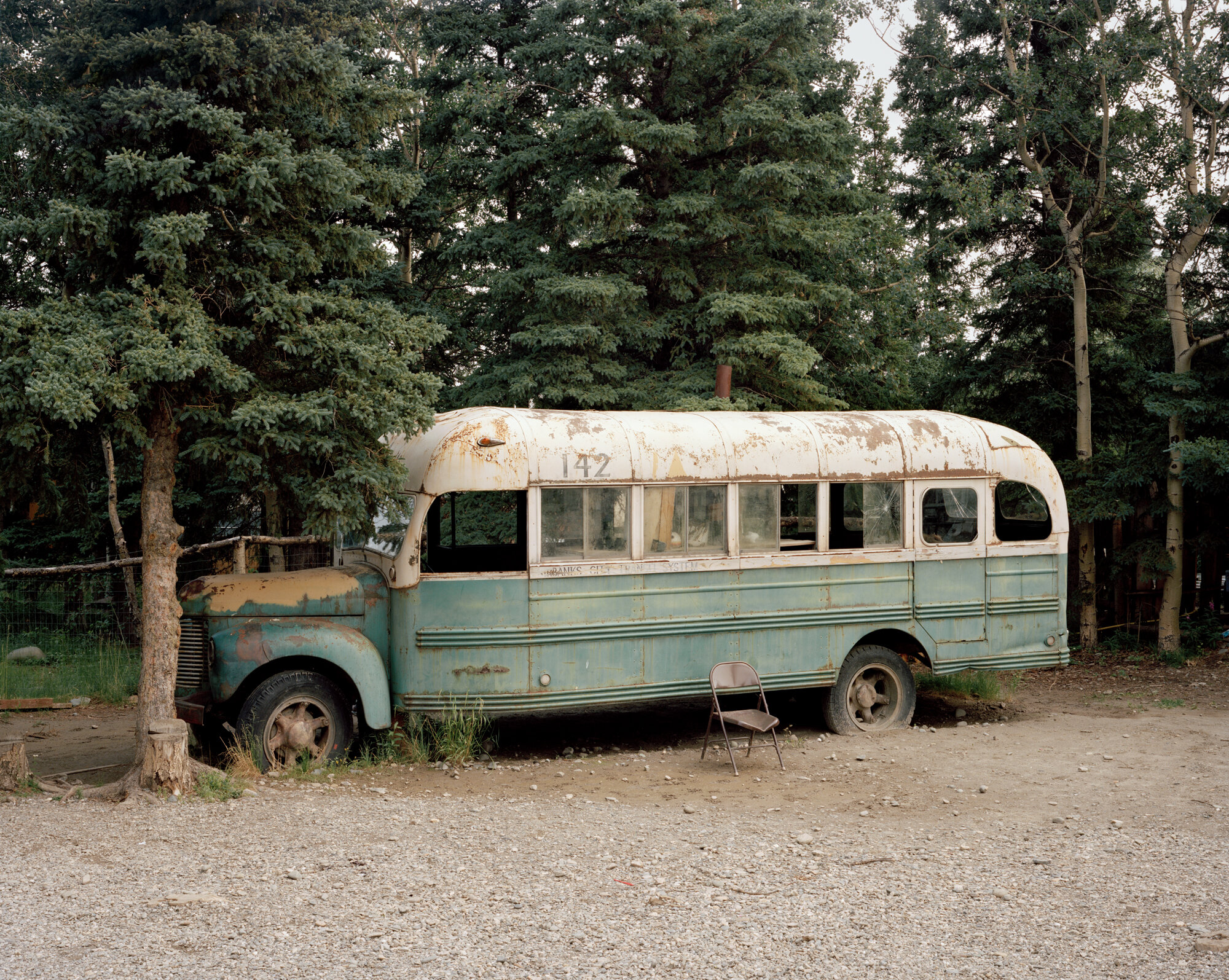
Venice Beach, California, 2008
In 1998, a pickup basketball game on these courts turned into a confrontation between a group of neo-Nazis and African Americans. Derek Vinyard, a young skinhead leader, stepped into the game and led his team to victory, taunting his opponents with a swastika tattoo on his chest. The black men were told to leave and never come back.
Later that night, a number of black players attempted to steal Vinyard’s truck outside his home. Vinyard drew his pistol, shooting and killing one man while injuring a second. Wounded and bleeding, the young man tried to crawl away but Vinyard forced him to open his mouth onto a concrete curb where he kicked in the back of his head, killing him instantly. Derek Vinyard was sentenced to just three years in prison for voluntary manslaughter.

Century Plaza Towers, 2040 Avenue of the Stars, Century City, California, 2008
On June 17, 1972, five men were arrested inside the offices of the Democratic National Committee on the sixth floor of the Watergate Hotel in Washington D.C. The burglary aroused suspicion and media attention because of the unusual circumstances of the crime. The men were found with $2,300 in sequential hundred-dollar bills, walkie-talkies, lock picks, door-jimmys, a police scanner, two cameras along with 40 rolls of unused film and sophisticated recording devices. One of the men was a former CIA agent and current security guard for President Nixon's Committee to Re-elect the President. Notebooks found on two of the men contained a phone number followed by the inscription 'W House.'
Washington Post reporters Bob Woodward and Carl Bernstein researched the case and wrote coverage of the story over a period of two years eventually uncovering evidence that implicated members of the Nixon administration. Woodward's secret source for much of the information was a highly placed official within the Executive Branch, code name Deep Throat. Only Woodward knew of the man's identity and the two would meet in this parking garage to relay information.

Bodega Bay, California, 2008
Melanie Daniels was boating across this bay when she was unexpectedly and violently struck in the head by a passing bird. The incident was the first in a dramatic series of unprompted bird attacks that plagued the town of Bodega Bay in 1963. Witnesses reported massive migrations of sparrows, seagulls, and crows overwhelming people and property on ten separate occasions. The birds seemed to deliberately attack in waves, resulting in dozens of injuries and the deaths of at least three people. The birds’ behavior could not be explained.

Maplewood Drive and Old Centreville Rd, Manassas, Virginia, 2008
On the night of June 23, 1993, John Wayne Bobbitt came home late after a night of drinking. John's wife Lorena was awoken by his attempts to initiate sexual intercourse but she complained about his unwillingness to allow her to orgasm and refused his advances. Falling in and out of consciousness, John then allegedly forced her to have sex. Afterwards, John passed out on the bed while Lorena went to the kitchen to get a drink of water. She noticed a large kitchen knife on the counter and with thoughts of previous abuse in her head, Lorena grabbed the knife and proceeded to the bedroom where she violently cut off more than half of John's penis.
Lorena immediately drove off with John's penis, which she threw out of her car window into this grassy area less than a mile from their home. She later gathered herself and called 911, informing authorities of the situation and the location of the penis. John, who was severely injured and bleeding, was helped by a friend to a nearby hospital. Teams of police and fire department personnel were dispatched to the scene to recover the penis and after a nine-hour surgery, John's penis was successfully reattached.
Lorena Bobbitt was tried for malicious wounding in 1994 but was found not guilty by reason of temporary insanity. After his surgery, John Wayne Bobbitt made a brief living as a porn star, appearing in such films as Frankenpenis and John Wayne Bobbitt - Uncut.

Healy, Alaska, 2015

Lake Berryessa, California, 2015

Farmers and Merchants Bank Building, Pilot Point, Texas, 2007
Bonnie Parker first saw Clyde Barrow as he was attempting to steal her mother's car in 1930. That same day, Bonnie watched as Clyde robbed a general store and the two drove off together. The duo soon teamed up with Clyde's brother Buck and a number of other accomplices to form the Barrow Gang. Over the next four years, the gang robbed numerous establishments in Texas, Oklahoma, Missouri and Iowa, including this bank.
In 1934, Bonnie and Clyde were ambushed by Louisiana police officers who were tipped off by an accomplice's father. Without warning or an attempt to make an arrest, four police officers fired approximately 130 rounds into the fugitives' car, killing both instantly. Bonnie Parker was 23 years old, Clyde Barrow was 25.

Christ Lutheran Church, Park City, Kansas, 2008
In 1974, four members of the Otero family were found bound and strangled inside their home in Wichita, Kansas. It was the first in a series of unsolved murders that would similarly claim the lives of 10 people. For over 14 years, a man known only as BTK, claimed responsibility for the crimes through a series of correspondence with police and local news media. A number of phone calls were made along with numerous letters and postcards until 1991 when they suddenly stopped.
Many believed the killer to be dead or incarcerated until 2004 when new letters began to surface along with items taken from the crime scenes. In one of 11 new communications with authorities, the killer mailed a package containing a floppy disk to Fox TV station KSAS.
Police found data from a deleted file on the disk and immediately traced it back to this church just outside Wichita. The man responsible for the document was Dennis Rader, a married boyscout leader, father of two and president of the church's congregation. Rader was taken into custody on February 25, 2005 where he confessed to all ten murders.

White Oak Road, Nickel Mines, Pennsylvania, 2008
At approximately 10:25 am on October 2, 2006, Charles Roberts drove to the West Nickel Mines School, a one-room Amish schoolhouse in Lancaster County, Pennsylvania. Brandishing a 9mm handgun, he ordered the male students to help carry lumber, wire, nails, chains, a stun-gun, two knives, ammunition and a shotgun, along with one small bag into the schoolhouse from his pickup truck. The bag contained a change of clothes, toilet paper, candles, sexual lubricant and flexible plastic ties. After allowing all the male students to leave, along with parents and infants, he barricaded the front door and began to tie up the young girls remaining. Police and EMT personnel arrived within minutes of a 911 call and immediately surrounded the building, ordering Roberts to surrender. Just after 11:00 am, gunshots were heard from inside the schoolhouse. As police attempted to enter through the windows, Roberts turned the gun on himself and pulled the trigger. Five girls, ages 7 to 13 were killed, and five others were severely wounded from execution-style gunshots to the back of the head.
The Amish community responded with public statements of forgiveness for the incident and on October 12, 2006 the one-room schoolhouse, which stood on this site, was demolished.

Kramerbooks & Afterwords, 1517 Connecticut Avenue NW, Washington, DC, 2008

North Leg, Gateway Arch, St. Louis, Missouri, 2009
On the morning of November 22, 1980 accomplished skydiver Kenneth Swyers called his wife and asked her to meet him at the Gateway Arch. The couple had recently watched a television program called Daredevils! and Swyers had mentioned a desire to be photographed gliding through the Arch. At 8:50 am, Swyers jumped from a single-engine plane and parachuted to the top of the Gateway Arch. Almost immediately, a strong gust of wind caught his parachute, throwing him off balance and sending him sliding down the north leg of the arch. As his wife looked on, Swyers fell some 630 feet and landed here on the terrazzo with nothing to break his fall. He was pronounced dead later that day.

Forest Lawn Memorial Park, Burbank, California, 2007
In 1862, a Confederate food transport was en route to soldiers when it was misdirected and surrounded by Union troops. General Robert E. Lee ordered an attempt to rescue the rations resulting in the Battle of Petersburg. It was here that Confederate troops led by Colonel Ben Cameron attacked the Union entrenchments under Captain Phil Stoneman. The two men were childhood schoolmates whose families were very close despite being from different sides of the Mason Dixon line. Colonel Cameron and his men had already overtaken two waves of opposition when he unexpectedly delayed an advance to come to the aid of a wounded Union soldier. Northern troops cheered when they saw the gesture and the colonel's life was spared when his final charge was ineffective and most of his men were killed.

Oregon State Hospital, Salem, Oregon, 2007
Randall McMurphy was serving a short prison term for statutory rape when he was transferred to a psychiatric ward for his belligerent and erratic behavior. During his stay he forged close relationships with several other inmates including Billy Bibbit and "Chief" Bromden. Together these men devised a plan to escape the maximum security facility.
Before they were able to execute their plan, Billy Bibbit committed suicide by stabbing himself in the neck with a piece of glass. McMurphy became so enraged over the sight that he attempted to strangle the head nurse whom he blamed for the incident. He was subdued by guards and taken away to receive the hospital's most radical form of therapy at that time - a lobotomy. He was returned to the ward later that night in a vegetative state. The next morning his body was found in bed, apparently suffocated, and these windows were broken. "Chief" Bromden was the only inmate missing and was never seen again.

Seneca Creek State Park, Gaithersburg, Maryland, 2009
Student filmmakers Heather Donahue, Michael Williams and Joshua Leonard disappeared somewhere in these woods near Burkittsville, Maryland in October 1994. The students had set out to make a documentary about a local legend known to haunt the surrounding area.
One year later, badly deteriorated video and sound equipment was found belonging to the three students. The fragmented footage showed the team getting lost and growing despondent over a period of days. Mysterious events were partially recorded including the sounds of strange screaming, a collection of stick figures hanging from trees and the appearance of partial human remains outside their tent. The last frames of footage show the basement of an abandoned house located deep within the woods. Screams can be heard and the camera appears to fall to the ground. The three students are still considered missing, but are presumed dead.

Snake River Canyon, Twin Falls, Idaho, 2008
Professional daredevil and motorcyclist Evel Knievel attempted to jump this canyon using a rocket-powered Sky-Cycle on September 8, 1974. The $150,000 craft which was built specifically for the jump had never been successfully tested. Despite the danger, Evel decided to honor his agreement with ABC's Wide World of Sports to broadcast the event live on that particular day. Almost immediately following takeoff a parachute deployed prematurely from the rear of the vehicle catching winds and causing the craft to drift backwards into the canyon. Knievel fell over 600 feet down onto the rocks below, narrowly avoiding the Snake River and sustaining only minor injuries. He would never attempt the jump again.

Morven Park, Leesburg, Virginia, 2015

Joshua Tree National Park, California, 2007
Gram Parsons was only 26 years old when he died of a drug overdose in a motel in Joshua Tree, California. Funeral arrangements were made in Louisiana and his body was taken to Los Angeles International Airport for transportation. Maintaining an earlier promise, Parsons' manager and a close friend managed to steal his body and drive it back to the desert in a borrowed hearse. After stopping for beer and gasoline, the two men came to Joshua Tree National Park where Parsons used to take LSD, write songs and look for UFO's. They placed his body here at this rock, doused it with gasoline and set it on fire.

Lakehurst Naval Air Station, Lakehurst, New Jersey, 2006
The German zeppelin, LZ 129 Hindenburg, was constructed in 1935 and advertised as the largest aircraft ever built. At a length of 804 ft, just 78 ft shorter than the Titantic, the Hindenburg was manufactured of an age-hardened aluminum alloy, skinned with cotton and filled with hydrogen. In its first two years of operation the zeppelin flew 191,583 miles including 17 roundtrips across the Atlantic and was present at the 1936 Olympic Games in Berlin, Germany.
On May 6, 1936, camera crews and reporters were on hand at the Lakehurst Naval Air Station in New Jersey to welcome the Hindenburg's first passenger flight of the year. Just moments before completing its voyage, the Hindenburg suddenly burst into flames and came crashing down, killing 36 people.
Although there were many theories behind the accident, it was widely believed to be a result of sabotage against Germany, though an official explanation was never determined. The incident, widely publicized by film and radio coverage, contributed largely to the end of giant airships as a means of passenger travel.

5001 Gibson Boulevard SE, Albuquerque, New Mexico, 2007
79-year-old Stella Liebeck ordered a cup of coffee from the passenger's seat of her grandson's car at this McDonald's drive-thru on February 27, 1992. Her grandson stopped the car so she could add cream and sugar and in the process of removing the lid, Stella spilled the entire drink into her lap. The coffee, which was served at a temperature over 180 degrees, caused third-degree burns and scalding over 6% of her body including her thighs, groin and buttocks. Stella was taken to the hospital where she stayed for eight days while undergoing a number of painful skin graft operations.
Stella Liebeck initially sought $20,000 to cover her medical expenses, but McDonald's refused to settle. A product liability lawsuit was then brought against McDonald's and in 1994 a jury awarded Liebeck $160,000 plus an additional $2.7 million in punitive damages. The final figure was settled out of court for an undisclosed amount.

Hollywood, California, 2007
Peg Entwistle was a young stage actress in New York City during the onset of the Great Depression. With theatre tickets sales dropping, the actress was involved in a series of Broadway failures in 1931. She migrated to Los Angeles in the spring of 1932 hoping to find salvation in the booming Motion Picture Industry. Without enough money to support herself, she moved in with her uncle on Beachwood Drive, just down the hill from the famous Hollywoodland sign. Peg's future seemed promising as she was cast in a number of roles, acting alongside Humphrey Bogart and in RKO's feature film Thirteen Women. But when her first film performance was almost entirely cut and her contract was allowed to expire, she became despondent and was unable to find work in film or theatre. At the age of 24, the actress sensed her career was over and slipped into a depression.
On the night of September 18, 1932 Peg Entwistle told her uncle she was going for a walk to a nearby drug store but instead made the difficult climb up the steep brush to the Hollywoodland sign. She neatly folded her coat at the base of the letter H and climbed a ladder to the top where she jumped 50 feet to her death.
Two days later Peg's uncle opened a letter from the Beverly Hills Playhouse which was sent the day before she jumped. It was an offer to play the lead role in their next production.

Desert Sands Motel, Albuquerque, New Mexico, 2008
Llewelyn Moss was hunting in a remote Texas desert in June of 1980 when he discovered a grisly scene of dead bodies. Upon inspection he found a man still clinging to life along with a massive amount of heroin in his truck bed. Under a nearby tree, he found another body with a black, leather satchel containing $2 million in cash. Moss decided to leave the injured man and head home with the money, only to return to the scene later that night to help the lone survivor. When he arrived just before dawn, he found the man had recently been shot and killed.
Moss was then chased by a group of men in a pickup truck who shot at him, wounding his right shoulder. Despite his injuries, Moss managed to escape and return home where he immediately told his wife to pack up everything and leave town. While she went to stay with her mother, Moss drove around from motel to motel trying to avoid his pursuers. He checked into room 114 of this motel where his body was later found shot to death in the doorway. No money was ever recovered.

Monument Valley Navajo Tribal Park, Utah, 2007
In 1868, Ethan Edwards returned to his brother's house after fighting for the Confederate Army in the Civil War. Shortly after his arrival, Comanche Indians raided the farm, killing his brother and sister-in-law along with their only son. Edwards' two nieces were kidnapped and the family's home was burned to the ground on this site.
Edwards assembled a search party to find the young girls and was able to locate the body of Lucy Edwards discarded in a nearby canyon. It would be nearly five years before they found her sister Debbie still living with her captors. A large company of men including several Texas Rangers attacked the tribe's camp and were able to free Debbie and return her safely home.

John D. Long Lake, near Union, South Carolina, 2006
On October 25, 1994 Susan Smith allowed her car to drift into this lake with her two sons trapped inside. The case received national attention when Smith claimed to have been carjacked by an African-American man before ultimately confessing nine days later.
In 1996, two families drove to this spot to pay their respects and visit a nearby memorial that had been erected. Without warning, one of the vehicles began to drift into the lake with five passengers trapped inside. Two adults jumped in to save their children but drowned along with everyone in the car.

Room 243, City Hall, Philadelphia, Pennsylvania, 2005
In 1993, twenty-seven year old Andrew Beckett was a successful attorney at Wyant Wheeler, Tetlow & Brown, one of the most powerful law firms in downtown Philadelphia. Beckett was gay and had contracted the HIV virus and although he tried to keep his personal life a secret, he began to show lesions on his skin when he developed full blown AIDS. Around this time, Beckett was fired under claims of inefficiency and failure to live up to his promise. He claimed that he was fired because of his illness and sexual orientation. Although it was difficult to find an attorney to represent him against his former boss, he sued on the grounds that it is against the law to dismiss an individual for a disability that does not prevent the fulfillment of his or her duties.
The trial lasted several months and was a landmark case in the gay community, bringing awareness to the AIDS epidemic and discrimination. Beckett’s illness grew worse and worse during the trial and when his former bosses were found guilty, he was in the hospital. He died just a few days after.

Alamo Village, Brackettville, Texas, 2007
In 1836, Texas was under the control of the Republic of Mexico when a mounting fight for independence began. Generalissimo Santa Anna launched an offensive of men north into Texas to quiet the rebellion. Some 7,000 Mexican forces met 185 Texans at this former Spanish mission in what came to be known as the Battle of the Alamo. The battle lasted 13 days and ended when the entire Texas army was killed.

Three Mile Island Nuclear Generating Station, Near Middleton, Pennsylvania, 2007
On Wednesday March 28, 1979 Reactor II of this nuclear power plant suffered a partial meltdown resulting in the most significant nuclear accident on American soil. No citizens were harmed in the accident and no illnesses or deaths have been attributed to the exposure of radioactive waste in the neighboring communities. The accident came at a crucial time of public opinion regarding the safety and efficiency of nuclear power followed by the disaster at Chernobyl in the Soviet Union in 1986. While much of the world continues its research and development of new sites, the production of new reactors has been halted dramatically in the United States.

Condor Street, Boston, Massachusetts, 2007
Three young boys were playing hockey on this street when their ball rolled into a sewer drain. As they searched for their ball they discovered a section of wet cement in the sidewalk and began writing their names in it when a car pulled up with two men inside. An older man posing as a police officer got out and questioned the kids about their behavior. One of the boys, Dave Boyle, was forced into the car and driven away. He was held captive in an old cellar where he was repeatedly molested over a period of four days before he managed to escape.

Babbage Street, Richmond Hills, Queens, New York, 2015

Joseph A. Sylvia State Beach, Martha’s Vineyard, Massachusetts, 2008
On July 1, 1975, the body of a young girl was found washed ashore on Amity Island, the victim of an apparent shark attack. Police Chief Martin Brody was encouraged not to close the beaches because of the revenue of the upcoming 4th of July weekend. A few days later, a young boy was killed in front of hundreds of tourists near this beach. A single shark was believed to be responsible for both incidents and all public beaches were ordered closed.
The next day, a large tiger shark was caught by local fishermen and the beaches were immediately reopened. A researcher from the nearby Oceanographic Institute insisted the bite radius was not large enough to match the attacks, but the beaches remained open. On July 4, 1975, onlookers watched from this beach as a great white shark swam into shallow waters and attacked a man in his boat, killing him instantly. The shark believed to be responsible was eventually found and destroyed.

Shanksville, Pennsylvania, 2007
On the morning of September 11, 2001, four commercial airplanes were hijacked on the eastern coast of the United States. Two aircraft were deliberately flown into the World Trade Center in New York City while another struck the Pentagon outside Washington D.C. The fourth plane was headed towards another target in the D.C. area when passengers on board received information about the other incidents. Fearing a similar catastrophe, several of the 37 passengers on board decided to storm the cockpit and force the terrorists into an immediate crash. At 9:58 am a frantic passenger placed a 911 call from inside the bathroom and stated that he heard some sort of explosion, saw white smoke and believed the plane was going down.
According to the FBI, United Airlines flight 93 crashed into a reclaimed coal mine on this site at 10:03 am. Airplane fuselage found over a small area was almost completely incinerated in the crash but additional debris, including an engine, was discovered two miles away. The remains of all 44 people on board were positively identified through DNA testing, including four known terrorists.





























